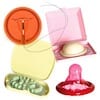Have you thought about long-term birth control choices? When you think about birth control, do you think about pills or condoms—or getting your “tubes tied?” Hey, it’s 2016! There are many other effective options.
Whether you want to delay or space your pregnancies or you just aren’t ready to do something permanent with your fertility, consider long-acting reversible contraception, or LARC.
Intrauterine devices (IUDs) and implants are LARCs. Most health insurance plans cover LARC and permanent birth control. In some states, a LARC can be inserted following your baby’s birth before you leave the hospital or birthing center; in most states, providers wait 6 weeks or more after a birth before inserting this contraceptive. LARCs are safe while nursing; your milk won’t be affected.
With so many choices, picking the best one may feel difficult. Learning about each method may help to make your decision easier.
Intrauterine devices (IUDs)
In the ‘70s, the earliest IUD proved problematic and unsafe due to its design; women developed uterine infections and had problems getting pregnant after its use. That was then; new IUDs are very different and safe. Nearly 8% of American women of all ages use an IUD!
IUDs are T-shaped and inserted into your uterus by a healthcare provider. Because an IUD is placed into your uterus through the vagina and cervix, insertion can feel crampy and sometimes painful. For most women, this feels like period cramps. Ibuprofen and relaxation techniques can help. IUDs are more than 99% effective, which makes them much more effective than birth control pills or condoms. There are some differences, though, among the 4 IUDs currently available: ParaGard®, Mirena®, Skyla® and Liletta™.
ParaGard
ParaGard is copper and plastic. Rather than using hormones, ParaGard works by preventing sperm from meeting up with an egg to make an embryo. It’s effective for up to 10 years, and can be used by women ages 17 to menopause. Because the ParaGard doesn’t contain hormones, it won’t change your cycle. IUDs don’t cause abortion, in case you’ve heard that false rumor. With ParaGard, you may have periods that are longer, heavier and crampier, particularly during the first 6 months of use. Sometimes, taking ibuprofen can make the flow lighter.
Mirena
Mirena has been available since 2000 and is made of levonorgestrel (a progestin hormone) and plastic. Mirena works by creates a mucus plug in your cervix to block sperm from meeting up with an egg. It also thins your uterine lining, impeding how sperm move and sometimes—but not always—preventing ovulation.
Effective for up to 5 years, it’s an option for women who have had a baby; still, many women who have never been pregnant use Mirena. With this IUD, your period is likely to change. Expect spotting or light bleeds after insertion. These can happen unexpectedly and frequently—how annoying! For most women, the bleeding is light and gets better with time. As many as 30% of women who use Mirena don’t have any bleeding at all.
Skyla
Syla, available since 2013, is made with the same hormone and plastic as Mirena, but it’s smaller and narrower with less hormone. This means it lasts for only 3 years. It works the same way to prevent pregnancy, but since it’s smaller and has less hormone, you’re more likely to have a monthly period with this IUD. It’s approved for all women regardless of pregnancy history.
Liletta
The newest of the bunch, Liletta, debuted last year (2015) and is made of the same plastic and hormone as Mirena and Skyla. Liletta is a “hybrid” between the two: It has the same amount of hormone as Mirena but is effective for 3 years like Skyla. It works the same way and can be used by all women regardless of pregnancy history. Depending on insurance benefits, this IUD may be less expensive.
The Contraceptive Implant
Nexplanon
Implants are the second type of LARC. Nexplanon is a single, very small rod—it’s only 4cm long and 2mm wide!—that’s inserted underneath your upper arm in a relatively painless procedure. First, numbing medicine is inserted into your arm—just a pinch!—so that it doesn’t hurt when the implant goes in. Nexplanon contains etonogestrel (a progestin hormone) that is similar to the hormone in Mirena, Skyla, and Liletta. It’s effective for 3 years and prevents pregnancy by preventing ovulation, forming the thick mucus plug in the cervix and making the inside of the uterus very thin.
Nexplanon is approved for all women regardless of whether they’ve had a baby. Some women who use the implant have irregular, frequent menstrual bleeding. Sometimes this bleeding can last for the whole 3 years and may be a reason you would want to stop using it. However, many women have light, normal periods, and some women have no bleeding at all.
Permanent Options
If you’re looking for permanent birth control, until recently, you could choose to have your “tubes tied” (surgical tubal ligation) or receive a non-surgical device called Essure. However, as of July 2018, Essure permanent birth control device will no longer be sold or distributed by Bayer, maker of Essure, after December 31, 2018.
Either option is a permanent decision about your fertility. Both tubal ligation and Essure are sterilization meaning you can’t ever become pregnant once you do either. These options aren’t reversible. Some research shows if you’re 30 or younger and choose sterilization, you may regret it later in life.
Tubal ligation
This is a surgical procedure usually performed in a hospital operating room. It can be performed any time; some women plan to have tubal ligation right after the birth of a baby, before going home from the hospital. With traditional tubal ligation, the surgeon cuts the fallopian tubes and then ties them off, which prevents an egg from entering a tube to meet up with sperm. Other methods include burning the ends of the tubes or using clips or rings to clamp them shut. Sometimes the fallopian tubes are completely removed, called a salpingectomy. Some studies have shown tubal ligation may lower your risks of ever having ovarian cancer.
Essure
Essure tubal ligation involves two small metal and fiber coils are placed into your fallopian tubes through the cervix. After insertion, scar tissue forms around the coils, blocking the tubes and preventing sperm from reaching an egg. Essure has been available since 2002, but since 2013 there has been concern that it might cause long-term pelvic pain, so talk to your healthcare provider about this before choosing Essure. In mid-2018, Bayer notified the U.S. Food and Drug Administration it would stop selling the device by year’s end following actions that the FDA took to address reports of serious adverse events associated with its use. Women using the Essure implant can continue to use it; the FDA will continue to monitor its postmarket safety. Women using Essure should tell their healthcare providers if they have symptoms, such as pain, that may be related to the device, as well as ask about the risks of removing the device versus continuing to use it.
The best birth control method is different for each woman. It’s important to learn about all methods so that whatever you choose is most effective for how you want to manage your fertility.
SOME FURTHER READING:
Pregnancy is the Perfect Time to Discuss Birth Control
Related articles








Comments are closed.